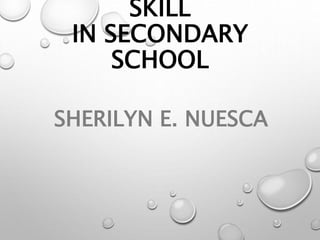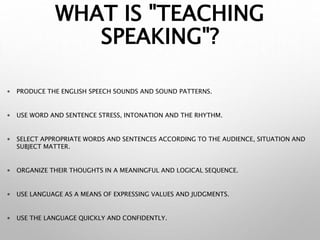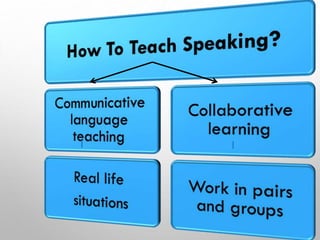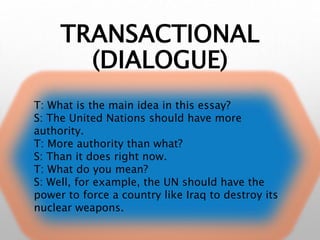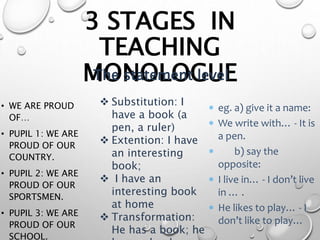Teaching Speaking
- 1. SKILL IN SECONDARY SCHOOL SHERILYN E. NUESCA
- 2. WHAT IS SPEAKING? Speaking is an interactive process of constructing meaning that involves producing and receiving and processing information (Brown, 1994. Burns & Joyce, 1997). Speaking is "the process of building and sharing meaning through the use of verbal and non-verbal symbols, in a variety of contexts“ (Chaney, 1998, p. 13).
- 3. WHAT IS "TEACHING SPEAKING"? PRODUCE THE ENGLISH SPEECH SOUNDS AND SOUND PATTERNS. USE WORD AND SENTENCE STRESS, INTONATION AND THE RHYTHM. SELECT APPROPRIATE WORDS AND SENTENCES ACCORDING TO THE AUDIENCE, SITUATION AND SUBJECT MATTER. ORGANIZE THEIR THOUGHTS IN A MEANINGFUL AND LOGICAL SEQUENCE. USE LANGUAGE AS A MEANS OF EXPRESSING VALUES AND JUDGMENTS. USE THE LANGUAGE QUICKLY AND CONFIDENTLY.
- 5. TEACHING SPEAKING SKILLS Oral communication Written communication Productive skills Receptive skills Listening Speaking Reading Writing
- 6. DEVELOPING ORAL COMMUNICATION SKILLS MAIN PROBLEMS: SYLLABUS REQUIREMENTS LANGUAGE AND SPEECH PHYSIOLOGICAL AND LINGUISTIC CHARACTERISTICS OF SPEECH WAYS OF CREATING SITUATIONS PREPARED, UNPREPARED AND INNER SPEECH TYPES OF EXERCISES.
- 7. LANGUAGE AND SPEECH LANGUAG E • PHILOLOGICA L • LOGICAL SPEECH • PSYCHOLOGIC AL • LINGUISTIC
- 8. PSYCHOLOGICAL CHARACTERISTICS OF SPEECH • SPEECH MUST BE MOTIVATED; • SPEECH IS ALWAYS ADDRESSED TO AN INTERLOCUTOR; • SPEECH IS ALWAYS EMOTIONALLY COLOURED; • SPEECH IS ALWAYS SITUATIONAL.
- 9. LINGUISTIC CHARACTERISTICS OF DIALOGUE SPEECH 1. THE USE OF INCOMPLETE SENTENCES (ELLIPSES) IN RESPONSE: E.G. WHERE DO YOU LIVE? - IN CHERKASSY. HOW MANY BOOKS DO YOU HAVE? – ONE. 2. THE USE OF CONTRACTED FORMS: DOESN’T, WON’T, HAVEN’T, CAN’T. 3. THE USE OF SOME ABBREVIATIONS: LAB, BIKE, MATH’S, FRIDGE, COMP, ETC. 4. THE USE OF CONVERSATIONAL TAGS.
- 11. TYPES OF CLASSROOM SPEAKING PERFORMANCE • 1. IMITATIVE • 2. INTENSIVE • 3. RESPONSIVE • 4. TRANSACTIONAL (DIALOGUE) • 5. INTERPERSONAL (DIALOGUE)
- 12. IMITATIVE TYPE • Keep them short (a few minutes of a class hour only). • Keep them simple (preferably just one point at a time). • Make sure students know why they are doing the drill. • Limit them to phonology or grammar points. • Make sure they ultimately lead to communicative goals. • Don't overuse them.
- 13. RESPONSIVE TYPE T: How are you today? S: Pretty good, thanks, and you? T: What is the main idea in this essay? S: The United Nations should have more authority. S1 So, what did you write for question number one? S2: Well, I wasn't sure, so I left it blank.
- 14. TRANSACTIONAL (DIALOGUE) T: What is the main idea in this essay? S: The United Nations should have more authority. T: More authority than what? S: Than it does right now. T: What do you mean? S: Well, for example, the UN should have the power to force a country like Iraq to destroy its nuclear weapons.
- 15. INTERPERSONAL (DIALOGUE) • a casual register; • colloquial language; • emotionally charged language; • slang; • ellipsis, etc.
- 16. TEACHING TWO FORMS OF SPEAKING Teaching Monologu e Teachin g Dialogu e
- 17. 3 STAGES IN TEACHING MONOLOGUE • WE ARE PROUD OF… • PUPIL 1: WE ARE PROUD OF OUR COUNTRY. • PUPIL 2: WE ARE PROUD OF OUR SPORTSMEN. • PUPIL 3: WE ARE PROUD OF OUR SCHOOL. eg. a) give it a name: We write with… - It is a pen. b) say the opposite: I live in… - I don’t live in … . He likes to play… - I don’t like to play… Substitution: I have a book (a pen, a ruler) Extention: I have an interesting book; I have an interesting book at home Transformation: He has a book; he The statement level
- 18. THE UTTERANCE LEVEL • Teacher: She cut her finger. • Pupil: Who cut her finger? • Class: Ann. • When did she cut it? • Yesterday. • What did she cut it with? • With a knife. • Why did she cut her finger? • Because the knife was sharp. • Pupil: yesterday Ann cut her finger. She cut it with a knife. The knife was sharp.
- 19. THE DISCOURSE LEVEL PUPILS ARE ASKED TO SPEAK ON A PICTURE, FILM COMMENT ON A TEXT THEY HAVE READ OR HEARD MAKE UP A STORY OF THEIR OWN. THE TEACHER SUPPLIES THE PUPILS WITH “WHAT TO SPEAK ABOUT.” E.G. “THE FARMER’S TREASURE” …
- 20. TEACHING DIALOGUE A conversation between 2 interlocutors. It is always situational and emotionally coloured. Dialogue is generally unprepared.
- 21. 3 STAGES IN TEACHING DIALOGUE 1.RECEPTIVE. 2.REPRODUCTION: IMMEDIATE; DELAYED; MODIFIED. 3.CONSTRUCTIVE OR CREATIVE.
- 22. 4 MAIN DIALOGUE STRUCTURES: 1. QUESTION - RESPONSE EG. -WHEN DID YOU VISIT YOUR DENTIST? - LAST WEEK. 2. STATEMENT - QUESTION E.G. – WE ARE GOING TO TRAVEL TO CRIMEA. - WHAT KIND OF TRANSPORT WILL YOU CHOOSE? 3. STATEMENT - STATEMENT E.G. – I’D LIKE TO GO TO THE CINEMA ON SATURDAY. - I ADVISE YOU TO VISIT THE CINEMA ON MONDAY OR TUESDAY. 4. QUESTION - QUESTION E.G. – CAN I HELP YOU? - HOW CAN I GET TO THE HOTEL?
- 24. SUGGESTIONS FOR TEACHERS IN TEACHING SPEAKING • PROVIDE MAXIMUM OPPORTUNITY TO STUDENTS TO SPEAK; • TRY TO INVOLVE EACH STUDENT IN EVERY SPEAKING ACTIVITY; • REDUCE TEACHER SPEAKING TIME IN CLASS; • INDICATE POSITIVE SIGNS; • DO NOT CORRECT STUDENTS' PRONUNCIATION MISTAKES VERY; • INVOLVE SPEAKING ACTIVITIES NOT ONLY IN CLASS BUT ALSO OUT OF CLASS; • CIRCULATE AROUND CLASSROOM TO ENSURE THAT STUDENTS ARE ON THE RIGHT TRACK;
- 25. CONCLUSION Teaching speaking is a very important part of language learning. The ability to communicate clearly and efficiently contributes to the success of the learner in school and success later in every phase of life. It makes students more active in the learning process and at the same time makes their learning more meaningful and fun for them.
- 26. REFERENCES 1. BROWN, G. AND G. YULE. 1983. TEACHING THE SPOKEN LANGUAGE. CAMBRIDGE: CAMBRIDGE UNIVERSITY PRESS. 2. BURNS, ANNE. 1998. TEACHING SPEAKING. ANNUAL REVIEW OF APPLIED LINGUISTICS 18, 102-123. 3. GREEN, F.E. CHRISTOPHER AND J.LAM. DEVELOPING DISCUSSION SKILLS IN THE ESL CLASSROOM. METHODOLOGY IN LANGUAGE TEACHING. NEW YORK: CAMBRIDGE UNIVERSITY PRESS. 225-234

